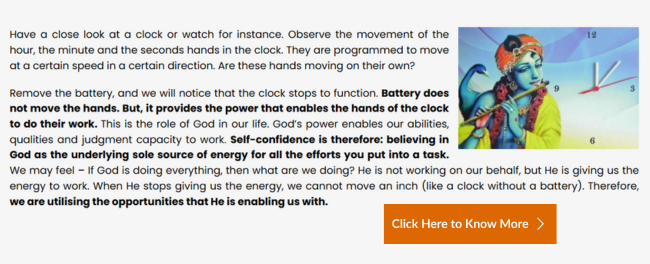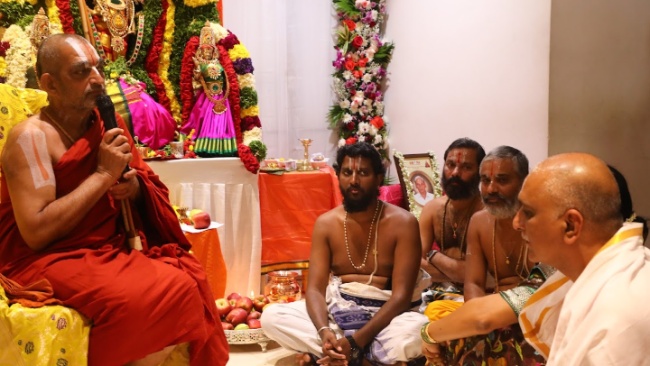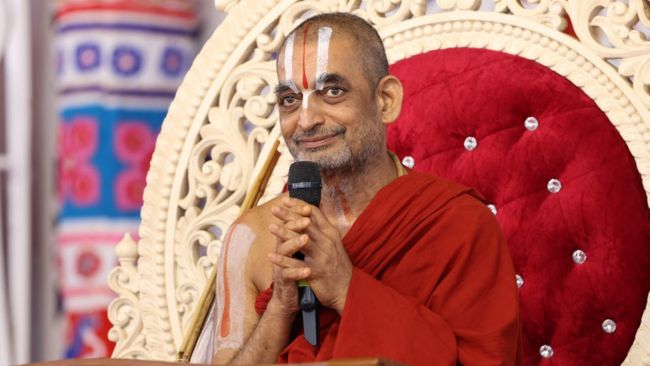
Namaha
Most of us are familiar with the way asto:ttharas are chanted. For example:
- O:m Ra:ma:ya Namaha
- O:m Ra:mabhadra:ya Namaha
- O:m Ra:machandra:ya Namaha
What does Namaha mean?
One of the ultimate truths of existence is reflected in this profound and powerful word: namaha. The root maha means “me” and expresses sva:rthathvam—the sense that “I am related to me,” or “I am for me.” The prefix na means “not”. Thus, namaha declares: “I am not about me.”
In the context of the Ashta:kshari Maha:mantra, Mumukshuppadi, an exposition of Pillai Lokacharya Swami, reveals the deeper truth of namaha as we, individual souls, are not meant for ourselves. We exist for the sake of the ultimate Supreme Soul, Bhagava:n. But naturally, we may ask: Why? Why are we not meant for ourselves? Why can’t we live for whatever purpose we choose?
Pause for a moment—and ask yourself honestly:
Are we truly able to do whatever we desire? Is our life fully under our control? If it were, wouldn’t we be doing far more than we are now? The reality is, we are only conditionally free.
Our freedom is limited—granted to us by a higher thatthva, the supreme reality. You may call it by any name that resonates with you for now. But can you deny that such an eternal thatthva, reality, exists?
Denying this truth—or refusing to bow down to it—is one of the greatest obstacles on the path to becoming a better, more wholesome individual, as well as on the path to liberation from the cycle of karma that binds us to this world. This is what Ravana did. This is what Kamsa did. This is what Hiranyakasipu did. This obstacle is known as ahamka:ra—the false ego.
The word namaha functions as a purifier—a kind of filter that cleanses the dangerous impurity of ahamkara, or ego. It helps remove the subtle yet deeply rooted dirt of false self-identity. Namaha plays this purifying role across all three foundational aspects of higher knowledge, each essential on the path to liberation:
Our lack of knowledge about who we truly are, our limitations, and the purpose of the body we inhabit leads us to view ourselves, others, and the things we use in ways that do not align with their true nature.

| Svaru:pa jna:na |
Knowledge of the true nature of the soul (Answering: “Who am I?”)
When you gain insight into the true nature of the soul to be se:shathva, it is easy to fall into the trap of thinking that it was ‘our’ intellect that led us to this discovery making one egoistic (ahanka:ra) and attached (mamaka:ra) to ourselves. But namaha filters out this ego-driven thought, reminding us that it is only through God’s compassion and initiative that such knowledge was revealed to us.
O:m namaha
Our lack of knowledge about who truly protects us and leads us to the ultimate goal makes us believe that we are independent and capable of managing everything on our own.

| Upa:ya jna:na |
– Knowledge of the means to attain liberation (Answering: “How does one reach the goal?”)
As one learns and seeks the Supreme as the means to attain liberation, the ego once again may lead one to believe it was swarakshana, their own effort to seek the Supreme that made it possible to be protected and liberated. Namaha corrects this thinking, asserting that it is by God’s compassion and action that one is even able to take up the right means in the first place.
Namo: namaha
Our lack of knowledge about who the ultimate recipient truly is leads us to believe we can take pride in and enjoy the results of our actions.

| Phala jna:na |
Knowledge of the soul’s ultimate goal (Answering: “What is the soul’s purpose?”)
Upon reaching the goal, one might once again get into swabho:gyatha: buddhi, take pleasure in the resulting state and assume it is theirs to enjoy. But namaha again steps in to filter this perception, teaching that the soul’s true fulfillment lies not in personal enjoyment, but in resuming its true role as bho:gya vastu—an object meant for God’s divine purpose.
Na:ra:yana:ya namaha
One wonders…
This kind of surrender or servitude seems impractical, unsettling, and a form of one-sided dominance. Does anything like it exist in the world?"
Consider a four-month-old child—no older—being dressed by the mother for a cradle ceremony. The ritual marks an important milestone and provides an occasion for blessings from friends and family. After dressing the baby, the mother looks at her child with joy. But does the baby truly have any awareness of what is happening? In fact, the baby might not even like it. The mother may then take the child into her lap, gaze at her lovingly, and coax a smile—and the baby smiles. This happens because the mother makes the baby smile.
The inanimate objects used in this ritual by the mother uses serve her purpose. The same can be said of the baby. Both fulfill the mother’s intention. The difference is that the inanimate objects cannot respond, whereas the baby does respond—when the mother makes her smile—because the baby has chaitanyam, life. Yet in both cases, they serve the mother’s purpose. The baby has abhithvath pa:rathantram, surrendered like the inanimate object.

What does such complete surrender mean for me and how is that fulfilling?
Such complete surrender explained by the word namaha carries within it the power to restore us to our natural state of being. It frees us from the burden of false knowledge, dissolves the thought of self-centeredness, and teaches us to live in joyful surrender—not for ourselves, but for the Supreme. In that surrender lies true relief, true freedom, and true fulfillment, for it is the Supreme who works tirelessly for the well-being of all existence. And what greater joy could there be than to participate in that well-being, of which we are an inseparable part?
Returning to the initial question: Why is namaha placed in the center of Asta:kshari Maha:mantra, rather than at the end as in other mantras?
Now that we understand how namaha cleanses us of the dirt of ahanka:ra, mamaka:ra , svarakshana do:sa, and svabho:ktruthva do:sha, we can see why it is revealed before the word Na:ra:yana:ya—unlike in other mantras, where it appears at the end.
Imagine a child crawling on the floor who finds something like a dead insect or dirt. The natural tendency is to put it into the mouth.

The mother, a few feet away, notices this and immediately says, “Drop it!” She does not take time to frame a complete sentence such as, “What you are holding is harmful. So, you must drop it from your hand now.” The first word she utters is “drop it!” because that is the immediate action the baby must take. Only afterwards will she utter all other words.
In the same way, the Veda—out of boundless compassion—reveals the essence of its teaching in the Asta:kshari Maha:mantra. It places namaha first, urging us to first cleanse ourselves of this dangerous obstacle – false ego and the resulting flaws, for it is the greatest hurdle on our path to liberation and joy.
– From the teachings of HH Chinna Jeeyar Swamiji
– Mumukshuppadi Class, 14th Sep 2025
-JIVA Asramam, Sri Ramnagar, Hyderabad, TS, India






This soul belongs to God. We (Body)have to surrender it to him with Bhakti.